Developing a Provenance Framework for Ancient Stone Materials: A Subduction-Related Serpentinite Case Study from Tinos, Cyclades, Greece
Abstract
1. Introduction
2. Materials and Methods
2.1. Electron Probe Microanalysis (EPMA)
2.2. Trace Element Analysis (LA-ICP-MS)
2.3. X-Ray Diffraction (XRD)
2.4. Raman Spectroscopy
2.5. Fourier Transform Infrared Spectroscopy (FTIR) and Brunauer–Emmett–Teller (BET) Analysis
2.6. Mechanical Properties Testing
2.7. Lichenometric Data
3. Geology of Tinos Island
4. Results
4.1. Field Work and Dating of the Quarry
4.2. Petrographic and Mineralogical Results
4.3. Physical Characteristics of Ras Serpentinite
4.4. Chemical Make-Up of the Material
5. Discussion
5.1. Geotectonic Settings and Conditions of Ras Serpentinite Formation
5.2. Geochemical and Physical Fingerprint of the Ras Serpentinite
5.3. Ras Serpentinite: Extraction, Function, and Chronology
6. Conclusions
Supplementary Materials
Author Contributions
Funding
Data Availability Statement
Acknowledgments
Conflicts of Interest
References
- Deschamps, F.; Godard, M.; Guillot, S.; Hattori, K. Geochemistry of Subduction Zone Serpentinites: A Review. Lithos 2013, 178, 96–127. [Google Scholar] [CrossRef]
- Koutsovitis, P. High-Pressure Subduction-Related Serpentinites and Metarodingites from East Thessaly (Greece): Implications for Their Metamorphic, Geochemical and Geodynamic Evolution in the Hellenic–Dinaric Ophiolite Context. Lithos 2017, 276, 122–145. [Google Scholar] [CrossRef]
- Evans, B.W.; Hattori, K.; Baronnet, A. Serpentinite: What, Why, Where? Elements 2013, 9, 99–106. [Google Scholar] [CrossRef]
- Horodyskyj, U.; Lee, C.-T.A.; Luffi, P. Geochemical Evidence for Exhumation of Eclogite via Serpentinite Channels in Ocean-Continent Subduction Zones. Geosphere 2009, 5, 426–438. [Google Scholar] [CrossRef]
- Schwartz, S.; Guillot, S.; Reynard, B.; Lafay, R.; Debret, B.; Nicollet, C.; Lanari, P.; Auzende, A.L. Pressure–Temperature Estimates of the Lizardite/Antigorite Transition in High Pressure Serpentinites. Lithos 2013, 178, 197–210. [Google Scholar] [CrossRef]
- Magganas, A.; Koutsovitis, P. Composition, Melting and Evolution of the Upper Mantle beneath the Jurassic Pindos Ocean Inferred by Ophiolitic Ultramafic Rocks in East Othris, Greece. Int. J. Earth Sci. 2015, 104, 1185–1207. [Google Scholar] [CrossRef]
- Koutsovitis, P.; Magganas, A.; Ntaflos, T.; Koukouzas, N. Rodingitization and Carbonation, Associated with Serpentinization of Triassic Ultramafic Cumulates and Lavas in Othris, Greece. Lithos 2018, 320–321, 35–48. [Google Scholar] [CrossRef]
- Koutsovitis, P.; Magganas, A.; Ntaflos, T. Rift and Intra-Oceanic Subduction Signatures in the Western Tethys during the Triassic: The Case of Ultramafic Lavas as Part of an Unusual Ultramafic–Mafic–Felsic Suite in Othris, Greece. Lithos 2012, 144–145, 177–193. [Google Scholar] [CrossRef]
- Sideridis, A.; Zaccarini, F.; Koutsovitis, P.; Grammatikopoulos, T.; Tsikouras, B.; Garuti, G.; Hatzipanagiotou, K. Chromitites from the Vavdos Ophiolite (Chalkidiki, Greece): Petrogenesis and Geotectonic Settings; Constrains from Spinel, Olivine Composition, PGE Mineralogy and Geochemistry. Ore Geol. Rev. 2021, 137, 104289. [Google Scholar] [CrossRef]
- Sideridis, A.; Koutsovitis, P.; Tsikouras, B.; Karkalis, C.; Hauzenberger, C.; Zaccarini, F.; Tsitsanis, P.; Lazaratou, C.V.; Skliros, V.; Panagiotaras, D.; et al. Pervasive Listwaenitization: The Role of Subducted Sediments within Mantle Wedge, W. Chalkidiki Ophiolites, N. Greece. Minerals 2022, 12, 1000. [Google Scholar] [CrossRef]
- Sideridis, A.; Zaccarini, F.; Grammatikopoulos, T.; Tsitsanis, P.; Tsikouras, B.; Pushkarev, E.; Garuti, G.; Hatzipanagiotou, K. First Occurrences of Ni-Phosphides in Chromitites from the Ophiolite Complexes of Alapaevsk, Russia and Gerakini-Ormylia, Greece. Ofioliti 2018, 43, 75–84. [Google Scholar] [CrossRef]
- Sideridis, A.; Tsikouras, B.; Tsitsanis, P.; Koutsovitis, P.; Zaccarini, F.; Hauzenberger, C.; Tsikos, H.; Hatzipanagiotou, K. Post-Magmatic Processes Recorded in Bimodal Chromitites of the East Chalkidiki Meta-Ultramafic Bodies, Gomati and Nea Roda, Northern Greece. Front. Earth Sci. 2022, 10, 1031239. [Google Scholar] [CrossRef]
- Hinsken, T.; Bröcker, M.; Strauss, H.; Bulle, F. Geochemical, Isotopic and Geochronological Characterization of Listvenite from the Upper Unit on Tinos, Cyclades, Greece. Lithos 2017, 282–283, 281–297. [Google Scholar] [CrossRef]
- Stergiou, C.L.; Bekiaris, T.; Melfos, V.; Theodoridou, S.; Stratouli, G. Sourcing Macrolithics: Mineralogical, Geochemical and Provenance Investigation of Stone Artefacts from Neolithic Avgi, North-west Greece. Archaeometry 2022, 64, 283–299. [Google Scholar] [CrossRef]
- Grammatikakis, I.; Demadis, K.D.; Kyriakidis, E.; Cabeza, A.; Leon-Reina, L. New Evidence about the Use of Serpentinite in the Minoan Architecture. A μ-Raman Based Study of the “House of the High Priest” Drain in Knossos. J. Archaeol. Sci. Rep. 2017, 16, 316–321. [Google Scholar] [CrossRef]
- Melfos, V. Green Thessalian Stone: The Byzantine Quarries and the Use of a Unique Architectural Material from the Larissa Area, Greece. Petrographic and Geochemical Characterization. Oxf. J. Archaeol. 2008, 27, 387–405. [Google Scholar] [CrossRef]
- Koutsovitis, P.; Kanellopoulos, C.; Passa, S.; Foni, K.; Tsapara, E.; Oikonomou, G.; Xirokostas, N.; Vallianatou, Κ.; Mouxiou, Ε. Mineralogical, Petrological and Geochemical Features of the Unique Lapis Lacedaemonius (Krokeatis Lithos) from Laconia, Greece: Approach on Petrogenetic Processes within the Triassic Volcanic Context. Bull. Geol. Soc. Greece 2017, 50, 1903. [Google Scholar] [CrossRef][Green Version]
- Lazzarini, L.; Antonelli, F. Petrographic and Isotopic Characterization of the Marble of the Island of Tinos (Greece). Archaeometry 2003, 45, 541–552. [Google Scholar] [CrossRef]
- Armstrong, R.A. Lichen Growth and Lichenometry. In Recent Advances in Lichenology; Springer: New Delhi, India, 2015; pp. 213–227. [Google Scholar]
- Beschel, R.E. Dating Rock Surfaces by Lichen Growth and Its Application to Glaciology and Physiography (Lichenometry). In Geology of the Arctic; University of Toronto Press: Toronto, ON, Canada, 1961; pp. 1044–1062. [Google Scholar]
- Bull, W.B.; Brandon, M.T. Lichen Dating of Earthquake-Generated Regional Rockfall Events, Southern Alps, New Zealand. Geol. Soc. Am. Bull 1998, 110, 60–84. [Google Scholar] [CrossRef]
- McCarroll, D. Modelling Late-holocene Snow-avalanche Activity: Incorporating a New Approach to Lichenometry. Earth Surf. Process. Landf. 1993, 18, 527–539. [Google Scholar] [CrossRef]
- Birkenmajer, K. Lichenometric Dating of Raised Marine Beaches at Admiralty Bay King George Island South Shetland Islands West Antarctica. Bull. Pol. Acad. Sci. Earth Sci. 1981, 29, 119–128. [Google Scholar]
- Laundon, J.R. The Use of Lichens for Dating Walls in Bradgate Park, Leicestershire. Trans. Leic. Lit. Philos. Soc. 1980, 74, 11–30. [Google Scholar]
- Benedict, J.B. A Review of Lichenometric Dating and Its Applications to Archaeology. Am. Antiq. 2009, 74, 143–172. [Google Scholar] [CrossRef]
- Matthews, A.; Schliestedt, M. Evolution of the Blueschist and Greenschist Facies Rocks of Sifnos, Cyclades, Greece. Contrib. Mineral. Petrol. 1984, 88, 150–163. [Google Scholar] [CrossRef]
- Matthews, A.; Lieberman, J.; Avigad, D.; Garfunkel, Z. Fluid-Rock Interaction and Thermal Evolution during Thrusting of an Alpine Metamorphic Complex (Tinos Island, Greece). Contrib. Mineral. Petrol. 1999, 135, 212–224. [Google Scholar] [CrossRef]
- Okrusch, M.; Broecker, M. Eclogites Associated with High-Grade Blueschists in the Cyclades Archipelago, Greece; a Review. Eur. J. Mineral. 1990, 2, 451–478. [Google Scholar] [CrossRef]
- Bröcker, M. Blueschist-to-Greenschist Transition in Metabasites from Tinos Island, Cyclades, Greece: Compositional Control or Fluid Infiltration? Lithos 1990, 25, 25–39. [Google Scholar] [CrossRef]
- Breeding, C.M.; Ague, J.J.; Bröcker, M.; Bolton, E.W. Blueschist Preservation in a Retrograded, High-Pressure, Low-Temperature Metamorphic Terrane, Tinos, Greece: Implications for Fluid Flow Paths in Subduction Zones. Geochem. Geophys. Geosyst. 2003, 4, 1–11. [Google Scholar] [CrossRef]
- Hinsken, T.; Bröcker, M.; Berndt, J.; Gärtner, C. Maximum Sedimentation Ages and Provenance of Metasedimentary Rocks from Tinos Island, Cycladic Blueschist Belt, Greece. Int. J. Earth Sci. 2016, 105, 1923–1940. [Google Scholar] [CrossRef]
- Melidonis, N.G. The Geological Structure and Mineral Deposits of Tinos Island (Cyclades, Greece). Geol. Greece 1980, 13, 1–80. [Google Scholar]
- Bröcker, M.; Franz, L. Rb–Sr Isotope Studies on Tinos Island (Cyclades, Greece): Additional Time Constraints for Metamorphism, Extent of Infiltration-Controlled Overprinting and Deformational Activity. Geol. Mag. 1998, 135, 369–382. [Google Scholar] [CrossRef]
- Patzak, M.; Okrusch, M.; Kreuzer, H. The Akrotiri Unit on the Island of Tinos, Cyclades, Greece: Witness to a Lost Terrane of Late Cretaceous Age. Neues Jahrb. Geol. Palaontol. Abh. 1994, 194, 211–252. [Google Scholar] [CrossRef]
- Bröcker, M.; Kreuzer, H.; Matthews, A.; Okrusch, M. 40 Ar/39 Ar and Oxygen Isotope Studies of Polymetamorphism from Tinos Island, Cycladic Blueschist Belt, Greece. J. Metamorph. Geol. 1993, 11, 223–240. [Google Scholar] [CrossRef]
- Mastrakas, N.; St. Seymour, K. Geochemistry of Tinos Granite: A Window to the Miocene Microplate Tectonics of the Aegean Region. Neues Jahrb. Mineral. Abh. 2000, 175, 295–315. [Google Scholar] [CrossRef]
- Hellenic Survey of Geology and Mineral Exploration (HSGME) Tinos-Yaros Islands Sheet. 2003.
- Wootton, W.; Russell, B.; Rockwell, P. Stoneworking Tools and Toolmarks (Version 1.0). In The Art of Making in Antiquity: Stoneworking in the Roman World; King’s College: London, UK, 2013. [Google Scholar]
- Jakobitsch, T.; Anevlavi, V. Lichenometric Dating of Rock Surfaces in Ancient Quarries—A Case Study in Tinos Island (Greece). In Proceedings of the ASMOSIA XIII; Sonderschriften des Österreichischen Archäologischen Instituts: Vienna, Austria, 2025. [Google Scholar]
- Thommes, M.; Kaneko, K.; Neimark, A.V.; Olivier, J.P.; Rodriguez-Reinoso, F.; Rouquerol, J.; Sing, K.S.W. Physisorption of Gases, with Special Reference to the Evaluation of Surface Area and Pore Size Distribution (IUPAC Technical Report). Pure Appl. Chem. 2015, 87, 1051–1069. [Google Scholar] [CrossRef]
- Sun, S.-S.; McDonough, W.F. Chemical and Isotopic Systematics of Oceanic Basalts: Implications for Mantle Composition and Processes; Special Publications: London, UK, 1989; Volume 42. [Google Scholar]
- Pearce, J.A.; Parkinson, I.J. Trace Element Models for Mantle Melting: Application to Volcanic Arc Petrogenesis. Geol. Soc. Lond. Spec. Publ. 1993, 76, 373–403. [Google Scholar] [CrossRef]
- Mavrogonatos, C.; Magganas, A.; Kati, M.; Bröcker, M.; Voudouris, P. Ophicalcites from the Upper Tectonic Unit on Tinos, Cyclades, Greece: Mineralogical, Geochemical and Isotope Evidence for Their Origin and Evolution. Int. J. Earth Sci. 2021, 110, 809–832. [Google Scholar] [CrossRef]
- Pearce, J.A.; Barker, P.F.; Edwards, S.J.; Parkinson, I.J.; Leat, P.T. Geochemistry and Tectonic Significance of Peridotites from the South Sandwich Arc-Basin System, South Atlantic. Contrib. Mineral. Petrol. 2000, 139, 36–53. [Google Scholar] [CrossRef]
- Uysal, I.; Ersoy, E.Y.; Dilek, Y.; Kapsiotis, A.; Sarifakioğlu, E. Multiple Episodes of Partial Melting, Depletion, Metasomatism and Enrichment Processes Recorded in the Heterogeneous Upper Mantle Sequence of the Neotethyan Eldivan Ophiolite, Turkey. Lithos 2016, 246–247, 228–245. [Google Scholar] [CrossRef]
- Arai, S. Dunite—Harzburgite—Chromitite Complexes as Refractory Residue in the Sangun—Yamaguchi Zone, Western Japan. J. Petrol. 1980, 21, 141–165. [Google Scholar] [CrossRef]
- Arai, S. Origin of Podiform Chromitites. J. Asian Earth Sci. 1997, 15, 303–310. [Google Scholar] [CrossRef]
- Kokkaliari, M.; St. Seymour, K.; Tombros, S.F.; Koutsopoulou, E. Study of the Chromite Mineralization Associated to Ophiolites from Tinos Island, Attico-Cycladic Massif. Bull. Geol. Soc. Greece 2019, 55, 185. [Google Scholar] [CrossRef]
- Nikolaeva, K.; Gerya, T.V.; Connolly, J.A.D. Numerical Modelling of Crustal Growth in Intraoceanic Volcanic Arcs. Phys. Earth Planet. Inter. 2008, 171, 336–356. [Google Scholar] [CrossRef]
- Kodolányi, J.; Pettke, T. Loss of Trace Elements from Serpentinites during Fluid-Assisted Transformation of Chrysotile to Antigorite—An Example from Guatemala. Chem. Geol. 2011, 284, 351–362. [Google Scholar] [CrossRef]
- Kodolányi, J.; Pettke, T.; Spandler, C.; Kamber, B.S.; Gméling, K. Geochemistry of Ocean Floor and Fore-Arc Serpentinites: Constraints on the Ultramafic Input to Subduction Zones. J. Petrol. 2012, 53, 235–270. [Google Scholar] [CrossRef]
- Debret, B.; Nicollet, C.; Andreani, M.; Schwartz, S.; Godard, M. Three Steps of Serpentinization in an Eclogitized Oceanic Serpentinization Front (Lanzo Massif—Western Alps). J. Metamorph. Geol. 2013, 31, 165–186. [Google Scholar] [CrossRef]
- Cannaò, E.; Scambelluri, M.; Agostini, S.; Tonarini, S.; Godard, M. Linking Serpentinite Geochemistry with Tectonic Evolution at the Subduction Plate-Interface: The Voltri Massif Case Study (Ligurian Western Alps, Italy). Geochim. Cosmochim. Acta 2016, 190, 115–133. [Google Scholar] [CrossRef]
- Viti, C.; Collettini, C.; Tesei, T.; Tarling, M.S.; Smith, S.A.F. Deformation Processes, Textural Evolution and Weakening in Retrograde Serpentinites. Minerals 2018, 8, 241. [Google Scholar] [CrossRef]
- Bessac, J.-C. L’archéologie Des Carrières de Pierre de Taille En France Méditerranéenne. In Pierre et Archéologie; Presses Universitaires de Perpignan: Perpignan, France, 2002; pp. 15–44. [Google Scholar]
- Korres, M. The Stones of the Parthenon; J. Paul Getty Museum: Los Angeles, CA, USA, 2000. [Google Scholar]
- Doperé, F. Les Techniques d’extraction Dans La Carrière de Saint-Remy à Rochefort: Comment Faisaient-Ils? In Marbres Jaspés de Saint-Remy et de la Région de Rochefort; Société archéologique de Namur: Namur, Belgique, 2012; pp. 99–149. [Google Scholar]
- Doperé, F. Les Techniques d’extraction Dans Les Anciennes Carrières de Marbre Jaspé, Saint-Remy à Rochefort et Saint-Hubert à Humain Comme Références Chronologiques Documentées. In Actes du Colloque Autour des Marbres Jaspés; Société archéologique de Namur: Namur, Belgique, 2013; pp. 184–213. [Google Scholar]
- Doperé, F. L’extraction, Le Débitage et Le Façonnage Du Marbre Dans La Région de Rochefort. Une Histoire de Pierres, de Moines et de Curés, de Carriers et de Marbriers. In Les Carrières de l’entité de Rochefort; Toussaint, J., Ed.; Musée provincial des Arts anciens du Namurois: Namur, Belgique, 2014; Volume 63, pp. 39–137. [Google Scholar]
- de Ceukelaire, M. Belgisch Marmer; Academia Press: Ghent, Belgium, 2014. [Google Scholar]
- Papamichos, E.; Papanicolopulos, S.-A.; Larsen, I. Mechanical Behaviour and Properties. In Fracture and Failure of Natural Building Stones; Springer: Dordrecht, The Netherlands, 2025; pp. 71–92. [Google Scholar]
- Long, L.E. Extracting Economics from Roman Marble Quarries. Econ. Hist. Rev. 2017, 70, 52–78. [Google Scholar] [CrossRef]
- Petrounias, P.; Giannakopoulou, P.; Rogkala, A.; Stamatis, P.; Tsikouras, B.; Papoulis, D.; Lampropoulou, P.; Hatzipanagiotou, K. The Influence of Alteration of Aggregates on the Quality of the Concrete: A Case Study from Serpentinites and Andesites from Central Macedonia (North Greece). Geosciences 2018, 8, 115. [Google Scholar] [CrossRef]
- Sayyadi, A.; Mohammadi, Y.; Adlparvar, M.R. Effect of Serpentine Aggregates on the Shielding, Mechanical, and Durability Properties of Heavyweight Concrete. Int. J. Eng. 2022, 35, 2256–2264. [Google Scholar] [CrossRef]
- Pereira, D.; Yenes, M.; Blanco, J.A.; Peinado, M. Characterization of Serpentinites to Define Their Appropriate Use as Dimension Stone. Geol. Soc. Lond. Spec. Publ. 2007, 271, 55–62. [Google Scholar] [CrossRef]
- Santo, A.P.; Agostini, B.; Garzonio, C.A.; Pecchioni, E.; Salvatici, T. Decay Process of Serpentinite: The Case of the San Giovanni Baptistery (Florence, Italy) Pavement. Appl. Sci. 2022, 12, 861. [Google Scholar] [CrossRef]
- Petrounias, P.; Giannakopoulou, P.P.; Rogkala, A.; Sideridis, A.; Koutsovitis, P.; Lampropoulou, P.; Koukouzas, N.; Pomonis, P.; Hatzipanagiotou, K. Influence of Petrogenesis on the Engineering Properties of Ultramafic Aggregates and on Their Suitability in Concrete. Appl. Sci. 2022, 12, 3990. [Google Scholar] [CrossRef]

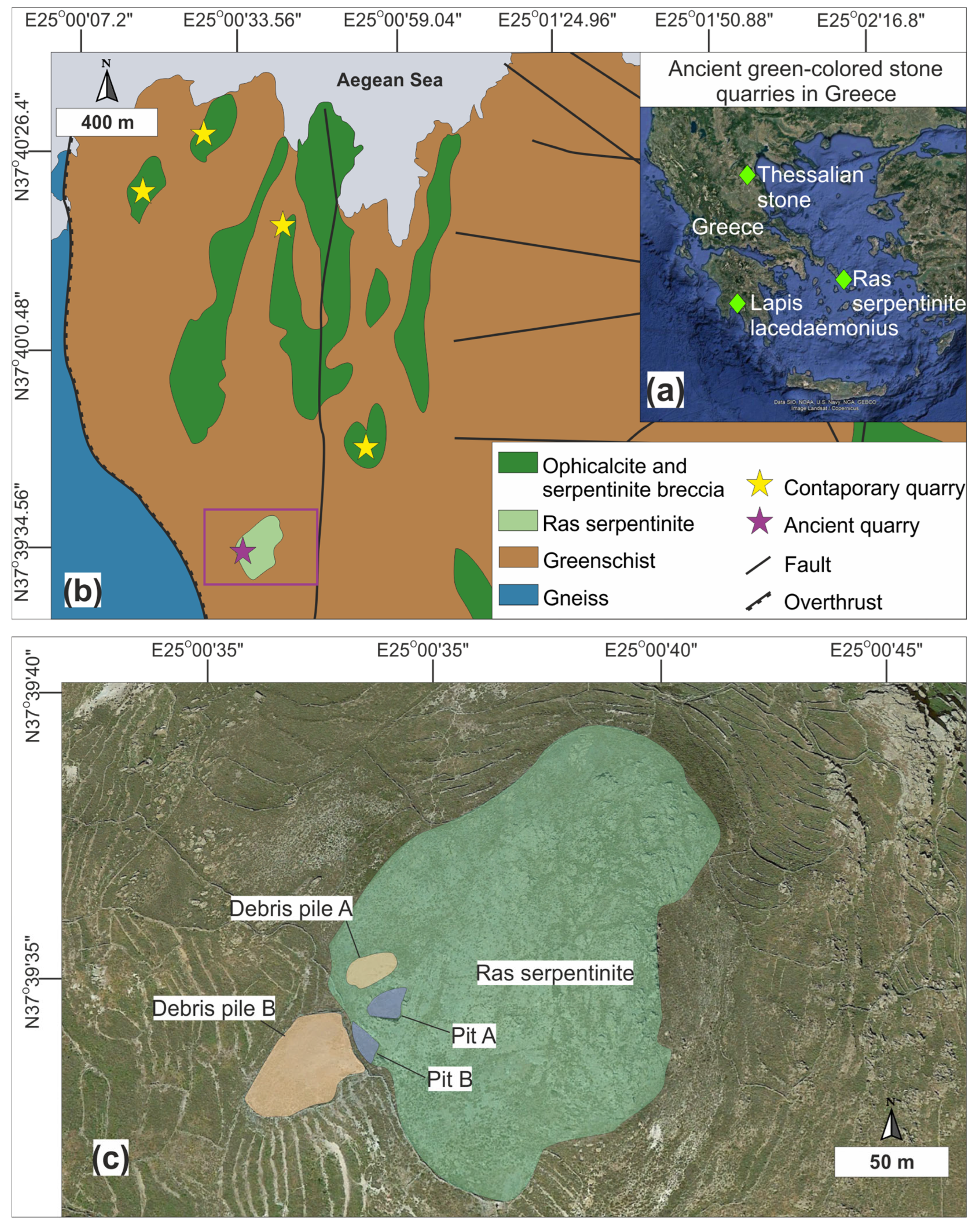
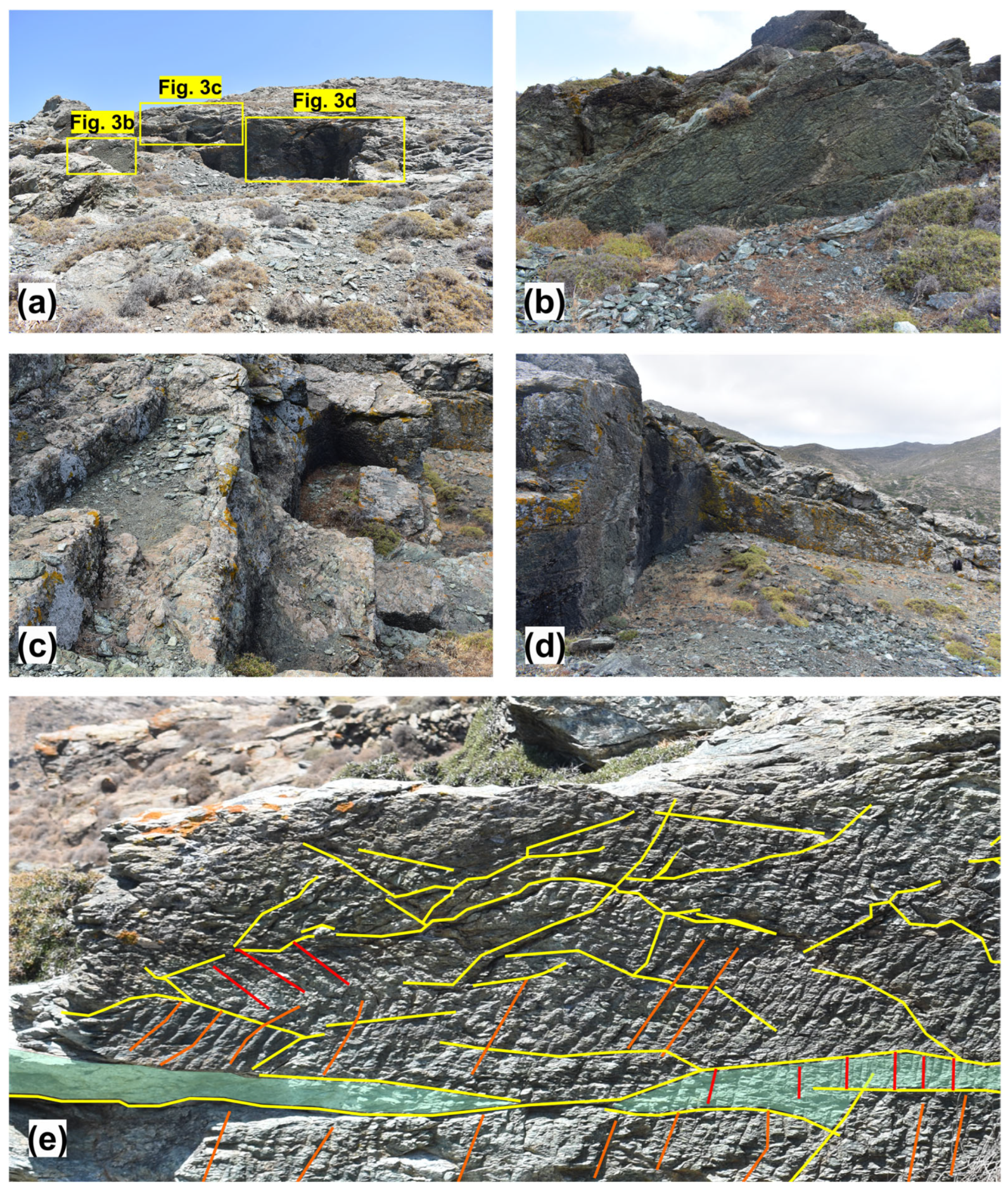
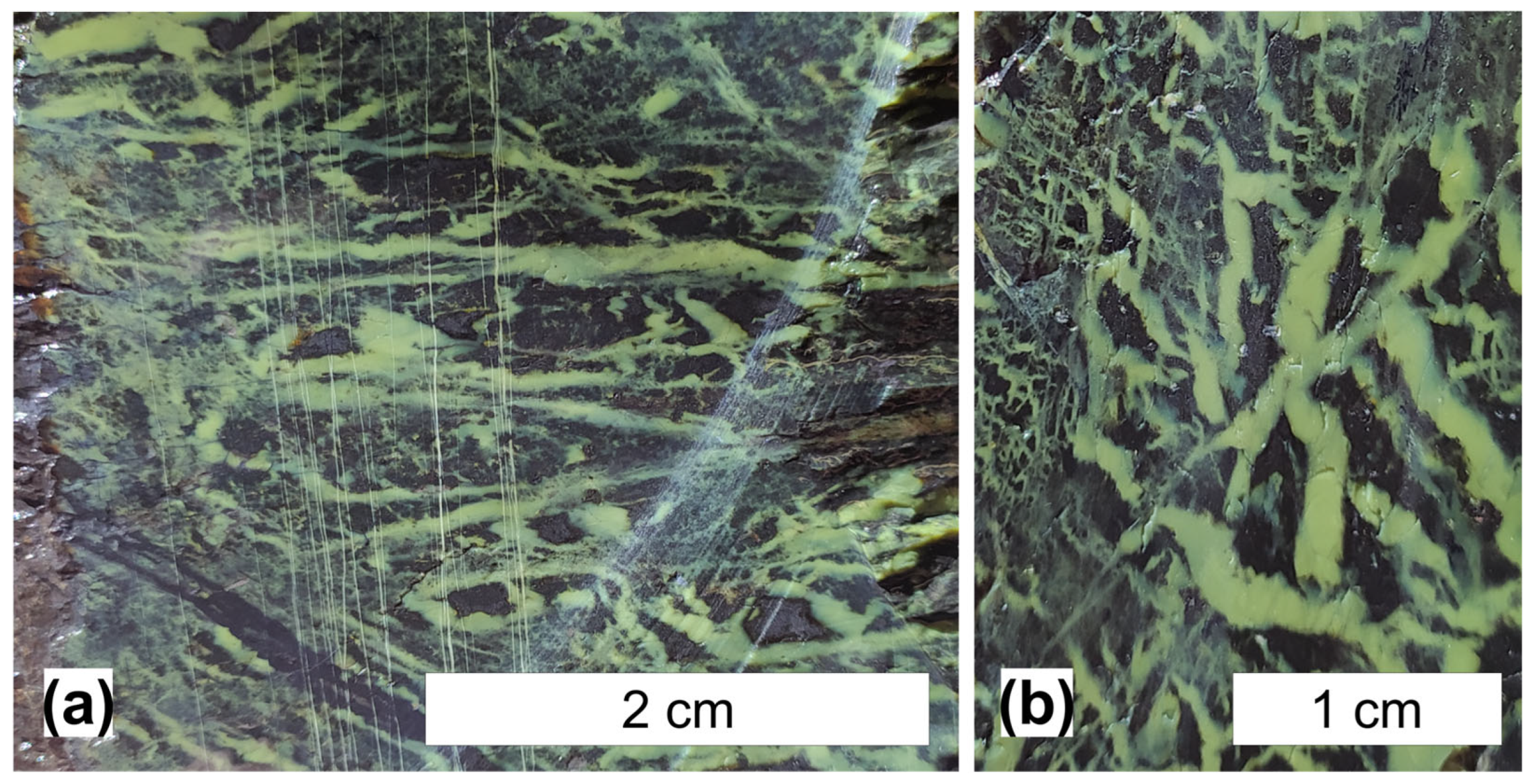
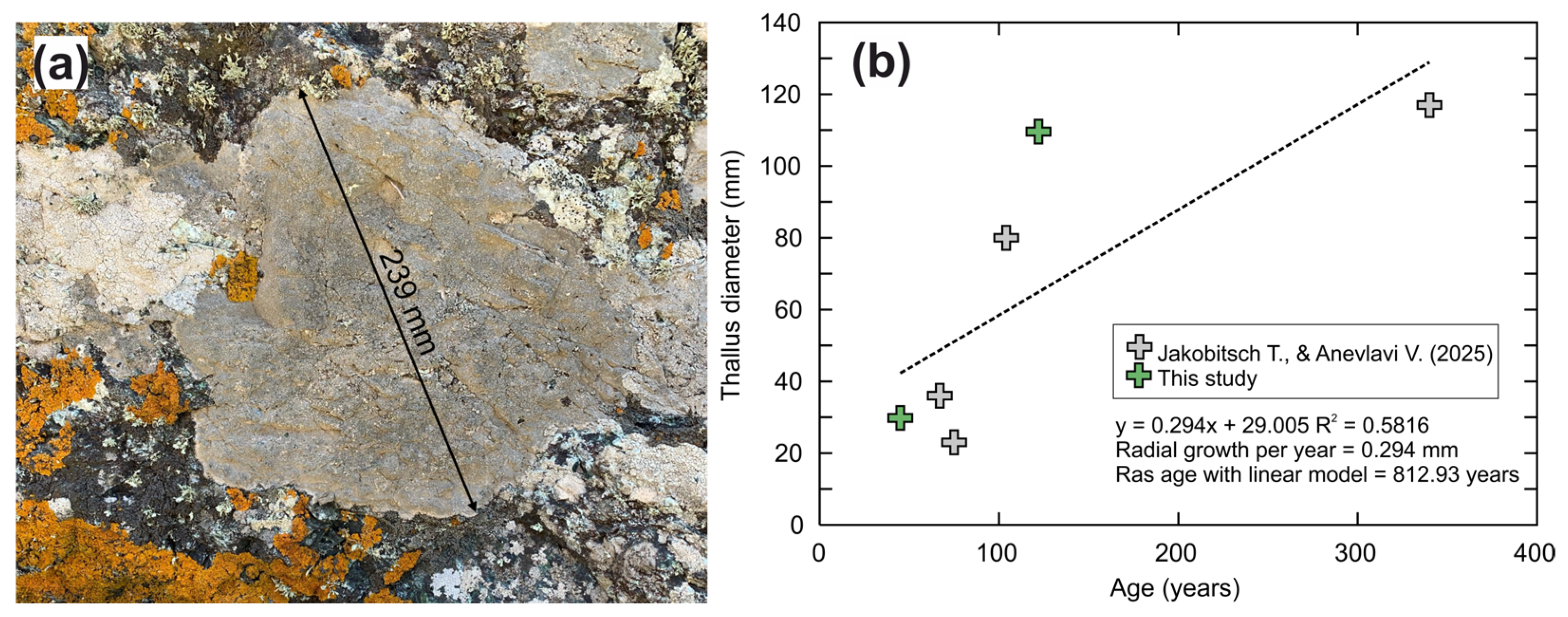


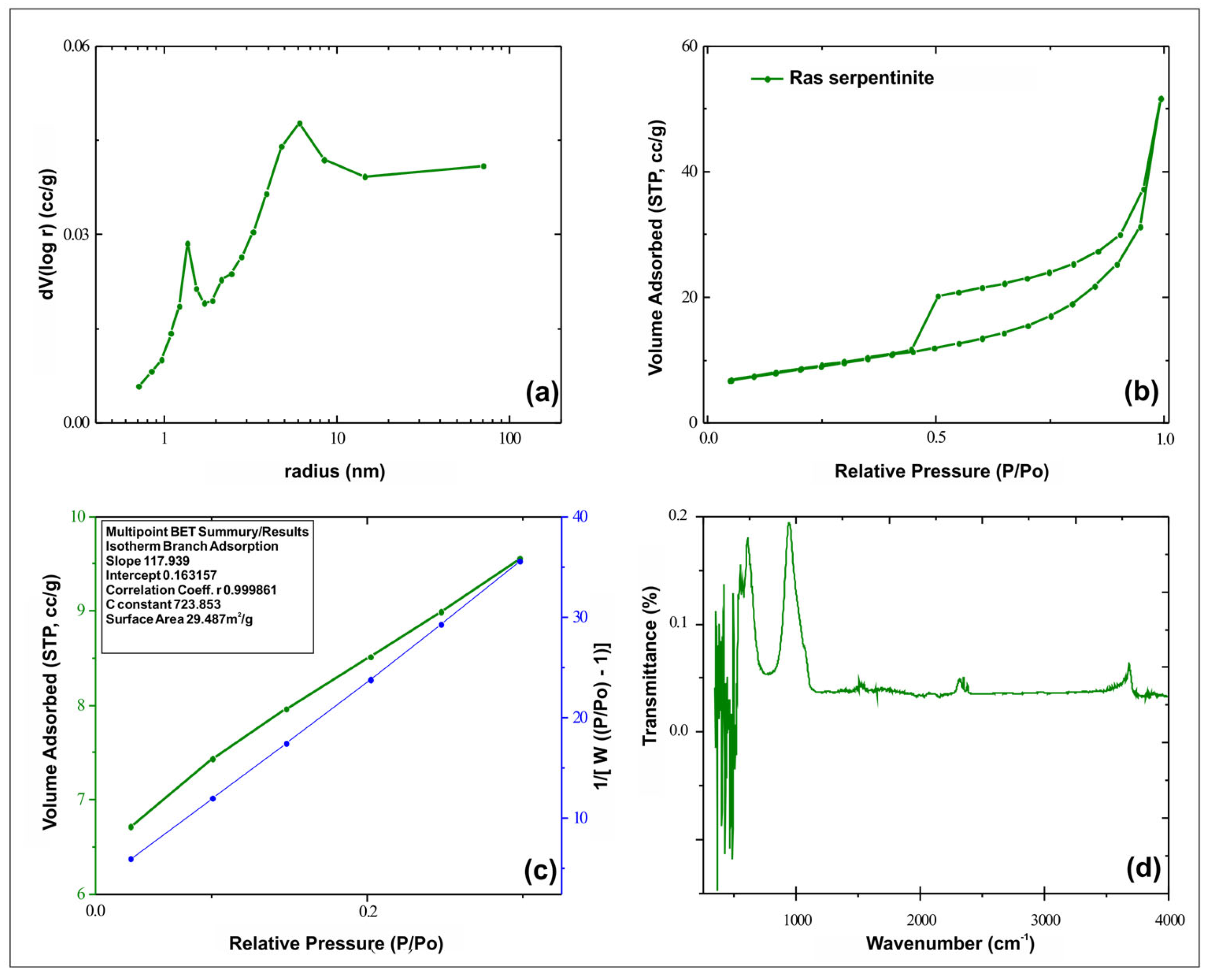
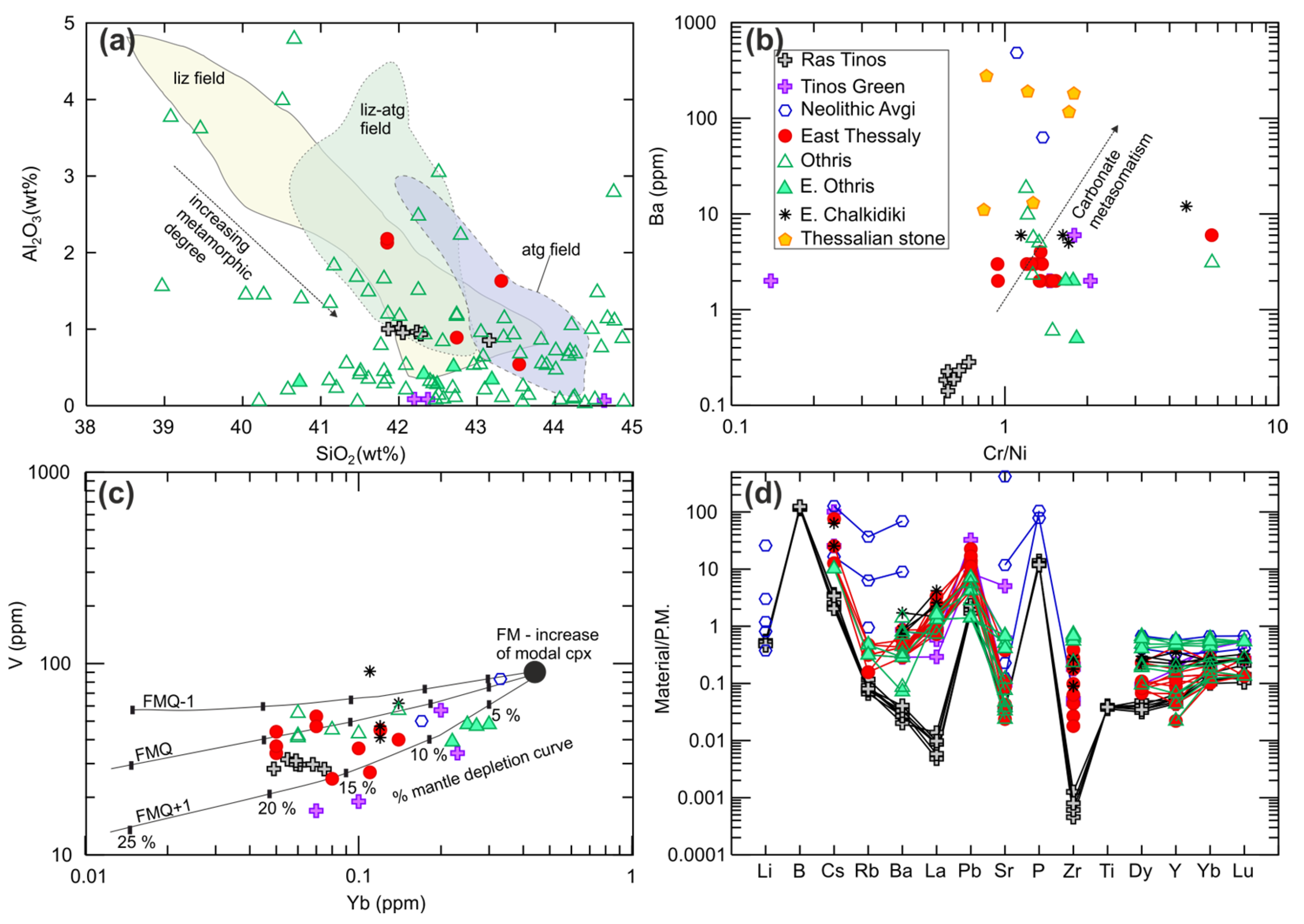
Disclaimer/Publisher’s Note: The statements, opinions and data contained in all publications are solely those of the individual author(s) and contributor(s) and not of MDPI and/or the editor(s). MDPI and/or the editor(s) disclaim responsibility for any injury to people or property resulting from any ideas, methods, instructions or products referred to in the content. |
© 2025 by the authors. Licensee MDPI, Basel, Switzerland. This article is an open access article distributed under the terms and conditions of the Creative Commons Attribution (CC BY) license (https://creativecommons.org/licenses/by/4.0/).
Share and Cite
Sideridis, A.; Anevlavi, V.; Tombros, S.F.; Hauzenberger, C.; Koutsovitis, P.; Boumpoulis, V.; Jakobitsch, T.; Petrounias, P.; Aggelopoulou, A. Developing a Provenance Framework for Ancient Stone Materials: A Subduction-Related Serpentinite Case Study from Tinos, Cyclades, Greece. Minerals 2025, 15, 568. https://doi.org/10.3390/min15060568
Sideridis A, Anevlavi V, Tombros SF, Hauzenberger C, Koutsovitis P, Boumpoulis V, Jakobitsch T, Petrounias P, Aggelopoulou A. Developing a Provenance Framework for Ancient Stone Materials: A Subduction-Related Serpentinite Case Study from Tinos, Cyclades, Greece. Minerals. 2025; 15(6):568. https://doi.org/10.3390/min15060568
Chicago/Turabian StyleSideridis, Alkiviadis, Vasiliki Anevlavi, Stylianos F. Tombros, Christoph Hauzenberger, Petros Koutsovitis, Vasileios Boumpoulis, Thorsten Jakobitsch, Petros Petrounias, and Anastasia Aggelopoulou. 2025. "Developing a Provenance Framework for Ancient Stone Materials: A Subduction-Related Serpentinite Case Study from Tinos, Cyclades, Greece" Minerals 15, no. 6: 568. https://doi.org/10.3390/min15060568
APA StyleSideridis, A., Anevlavi, V., Tombros, S. F., Hauzenberger, C., Koutsovitis, P., Boumpoulis, V., Jakobitsch, T., Petrounias, P., & Aggelopoulou, A. (2025). Developing a Provenance Framework for Ancient Stone Materials: A Subduction-Related Serpentinite Case Study from Tinos, Cyclades, Greece. Minerals, 15(6), 568. https://doi.org/10.3390/min15060568








